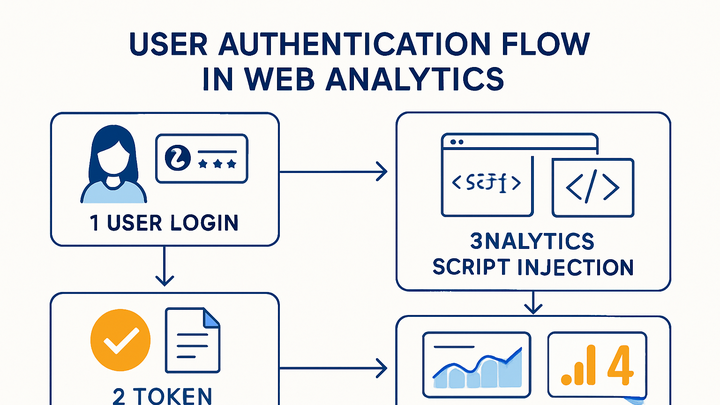Published on 2025-06-28T08:21:44Z
What is User Authentication? Examples of User Authentication in Analytics
User Authentication in analytics refers to the process of verifying the identity of website visitors to link their actions across sessions and devices. It ensures analytics platforms recognize returning users accurately, supporting personalized experiences, robust security, and compliance with privacy regulations like GDPR and CCPA. By assigning unique, persistent identifiers—often through login systems or tokens—tools like GA4 and PlainSignal can deduplicate users, attribute conversions correctly, and surface reliable insights. GA4’s User-ID feature enables cross-device tracking for logged-in users, while PlainSignal’s cookie-free model can integrate authenticated IDs without relying on third-party cookies. Implementing strong authentication not only boosts data quality but also builds user trust by respecting consent and privacy.
User authentication
Verifies user identities to enable accurate, privacy-compliant analytics and personalized insights across devices.
Why User Authentication Matters in Analytics
Verifying user identities provides a foundation for accurate data, personalization, and compliance across analytics workflows.
-
Data integrity
Ensures each user is consistently identified to prevent duplicate counts and distorted metrics.
-
Unique identification
Assign persistent user IDs after login to maintain continuity across sessions and devices.
-
Fraud prevention
Authenticate users to filter out bots and malicious actors, improving data reliability.
-
-
Personalized insights
Links user actions to individual profiles, enabling tailored recommendations, content, and marketing messages.
-
Security & compliance
Aligns tracking practices with regulations like GDPR, CCPA, and HIPAA by verifying user consent and identity.
-
Data minimization
Collect only the necessary user data and avoid storing sensitive personal information.
-
Consent management
Honor user opt-in and opt-out preferences during authentication and tracking.
-
Common Authentication Methods
A survey of widely used techniques to authenticate users in web applications and analytics platforms.
-
Cookie & session-based authentication
Stores session identifiers in cookies to maintain state on the server, tying requests to a user session.
-
Pros
Simple to implement and works in most browsers without extra setup.
-
Cons
Vulnerable to cookie theft and does not scale well for stateless architectures.
-
-
Token-based authentication (jwt)
Issues signed JSON Web Tokens to clients, which are sent with each request to verify identity.
-
Pros
Stateless and scalable, suitable for microservices and APIs.
-
Cons
Requires secure token storage and management on the client side.
-
-
Oauth 2.0 / openid connect
Delegates authentication to trusted identity providers like Google, Facebook, or corporate SSO systems.
-
Pros
Users can log in without creating new credentials; supports federated identity.
-
Cons
Complex to configure and may introduce external dependencies.
-
-
Saml
Uses XML-based assertions to enable single sign-on and federation in enterprise environments.
-
Pros
Robust enterprise-grade security and centralized identity management.
-
Cons
Heavyweight protocol with steep implementation complexity.
-
Integration with PlainSignal and GA4
Step-by-step examples to integrate authenticated user tracking using PlainSignal and Google Analytics 4.
-
PlainSignal integration example
Embed PlainSignal’s cookie-free script alongside your authentication mechanism to pass a persistent user ID to PlainSignal.
<link rel="preconnect" href="//eu.plainsignal.com/" crossorigin /> <script defer data-do="yourwebsitedomain.com" data-id="0GQV1xmtzQQ" data-api="//eu.plainsignal.com" src="//cdn.plainsignal.com/plainsignal-min.js"></script>-
Set user id
Ensure your application injects the same user ID value after the user logs in to maintain continuity.
-
Configure data attributes
Use data attributes or a custom PlainSignal field to transmit the user ID securely without cookies.
-
-
GA4 integration example
Configure GA4’s gtag snippet to include a
user_idparameter after authentication.<script async src="https://www.googletagmanager.com/gtag/js?id=GA_MEASUREMENT_ID"></script> <script> window.dataLayer = window.dataLayer || []; function gtag(){dataLayer.push(arguments);} gtag('js', new Date()); gtag('config', 'GA_MEASUREMENT_ID', { 'user_id': 'USER_ID' }); </script>-
Replace user_id
Dynamically insert the authenticated user’s ID in place of
USER_ID. -
Enable user-id feature
In your GA4 property settings, activate the User-ID reporting feature to visualize cross-device data.
-
-
Best practices
Recommendations to ensure secure and privacy-compliant user authentication workflows in analytics.
-
Hash or pseudonymize ids
Transform user identifiers to pseudonymous values before transmitting to analytics platforms.
-
Respect privacy preferences
Honor Do Not Track headers and explicit user consent when authenticating and tracking.
-
Monitor authentication metrics
Track login success rates and anomalies to detect potential issues or malicious activity.
-
